Central Florida Gardening Calendar1
January
What to Plant
Annuals/Bedding plants: Plants that can be added to the garden during the coolest months include dianthus, pansy, petunia, viola, and snapdragon. See Annuals: https://edis.ifas.ufl.edu/topic_annual_landscape_plants
Bulbs: Crinum, agapanthus, and gloriosa lily bulbs can be planted now. Provide a layer of mulch to protect from cold temperatures. See Bulbs for Florida: https://edis.ifas.ufl.edu/topic_bulbous_flowers
Camellias: Select and plant camellias this month. Visit local nurseries now for the best selection of colors and forms. See Camellias: https://edis.ifas.ufl.edu/topic_camellia

Credit: UF/IFAS
Vegetables: Irish potatoes can be planted now. Start with healthy seed pieces purchased from a local nursery or online seed catalog. Continue planting cool-season crops, including broccoli, kale, carrots, and lettuce. See Vegetable Gardening in Florida: https://edis.ifas.ufl.edu/topic_vegetable_gardening
What to Do
Deciduous fruit: Plant deciduous fruit trees now to give their roots time to develop before the warm, dry spring months. Prune and fertilize existing trees. See Temperate Fruit for the Home Landscape: https://edis.ifas.ufl.edu/topic_home_temperate_fruit
Cold protection: Be ready to cover tender plants to minimize damage and be sure covers extend all the way to the ground. Frost or freezes are likely this month and next. See Cold Protection and Chilling Damage of Landscape Plants: https://edis.ifas.ufl.edu/topic_landscapes_and_cold
Irrigation: Irrigate lawns and landscape plants minimally. This is their dormant season. See Landscape Irrigation: https://edis.ifas.ufl.edu/topic_landscape_irrigation
Shrubs and trees: Prune non-spring flowering shrubs and trees this month to improve form. See Pruning Landscape Trees and Shrubs: https://edis.ifas.ufl.edu/topic_tree_pruning
Arbor Day: Celebrate Florida Arbor Day (the third Friday of January) by planting a tree in your yard or community. See Arbor Day in Florida: https://edis.ifas.ufl.edu/topic_arbor_day
Crapemyrtle: Remove seed pods, crossing branches, and small twiggy growth to improve the appearance and form of the plant, if desired. Hard pruning is not required. See Crapemyrtle: https://edis.ifas.ufl.edu/topic_crapemyrtle
Pests: Apply horticultural oil to citrus, shrubs, camellias, and deciduous fruit trees while plants are dormant to control scale. See Landscape Pest Management: https://edis.ifas.ufl.edu/topic_landscape_pests
February
What to Plant
Annuals/Bedding plants: Plants that perform better in the cooler months include petunia, pansy, verbena, dianthus, strawflower, and lobelia. Protect from frosts and freezing temperatures. See Annuals: https://edis.ifas.ufl.edu/topic_annual_landscape_plants
Bulbs: Many bulbs can be planted now. Provide adequate water for establishment and protect from cold weather with mulch. Some examples include Amazon lily, crinum, and agapanthus. See Bulbs for Florida: https://edis.ifas.ufl.edu/topic_bulbous_flowers
Azaleas: With azaleas in full bloom this month, now is a great time to select varieties to add to the landscape. See Azalea: https://edis.ifas.ufl.edu/topic_azalea
Vegetables: Numerous warm- and cool-season vegetables can be planted this month. Protect cold-tender veggies if a frost or freeze is predicted. See Vegetable Gardening in Florida: https://edis.ifas.ufl.edu/topic_vegetable_gardening
What to Do
Palms: Give cold-damaged palms proper care to encourage their recovery. See Cold Protection and Chilling Damage of Landscape Plants: https://edis.ifas.ufl.edu/topic_landscapes_and_cold
Citrus: Check citrus trees for scab disease. Apply a copper fungicide when new leaves appear and again when two-thirds of the flower blossoms have fallen. See Home Citrus Culture: https://edis.ifas.ufl.edu/topic_citrus_home_citrus_culture
Roses: Prune roses this month to remove damaged canes and improve the overall form. After pruning, fertilize and apply a fresh layer of mulch. Blooming will begin 8–9 weeks after pruning. See Roses: https://edis.ifas.ufl.edu/topic_rose
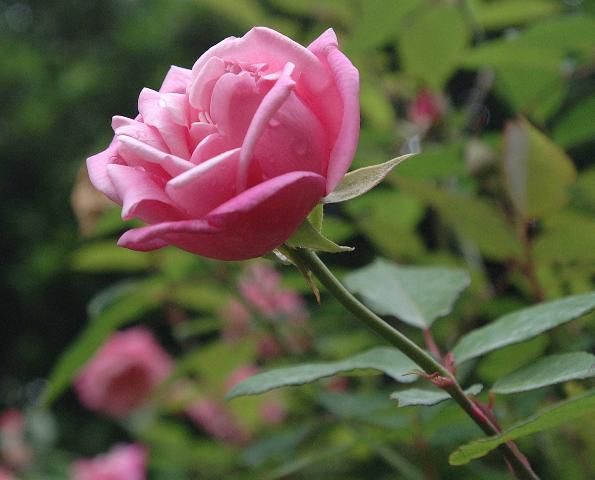
Credit: UF/IFAS Photo by Eric Zamora
Shrubs: Fertilize shrubs by spreading fertilizer evenly over the soil surface and watering it in. Follow with a fresh layer of mulch to conserve moisture and reduce weeds. See Landscape Fertilization: https://edis.ifas.ufl.edu/topic_landscape_fertilization
Lawn: Apply a preemergence weed killer (not a "weed and feed") to lawns this month to prevent germination of warm-season weed seeds. Apply when temperatures rise to 65°F for 4–5 days. Timing is important for good control. See Lawn Weeds: https://edis.ifas.ufl.edu/topic_lawn_weeds
Citrus and other fruit trees: Fertilize now if not done in January. Frequency and amount of fertilization depend on the age of the tree. See Home Citrus Culture: https://edis.ifas.ufl.edu/topic_citrus_home_citrus_culture and Temperate Fruit for the Home Landscape: https://edis.ifas.ufl.edu/topic_home_temperate_fruit
March
What to Plant
Annuals: Replace declining winter annuals with varieties such as angelonia, gazania, and salvia that will provide color now and into the summer months. See Annuals: https://edis.ifas.ufl.edu/topic_annual_landscape_plants
Bulbs: Plant caladium for a showy tropical display all summer. See Bulbs for Florida: https://edis.ifas.ufl.edu/topic_bulbous_flowers
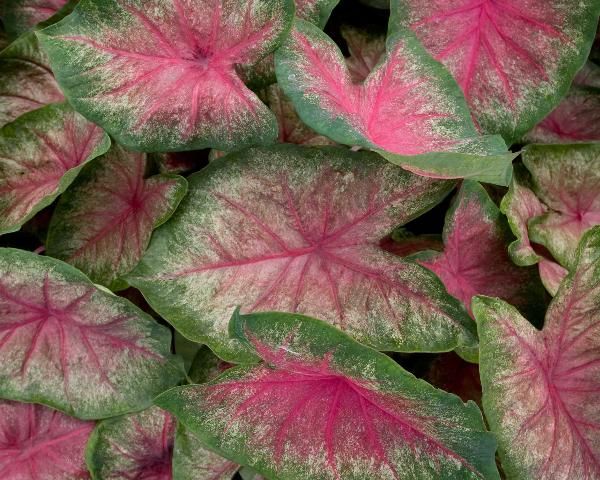
Credit: UF/IFAS Photo by Tyler Jones
Herbs: In addition to their culinary value, many herbs are ornamental and attract butterflies to the garden. See Herbs: https://edis.ifas.ufl.edu/topic_herbs
Vegetables: Warm-season crops, such as beans, peppers, squash, and others can be planted now. See Vegetable Gardening in Florida: https://edis.ifas.ufl.edu/topic_vegetable_gardening
What to Do
Azaleas: Prune azaleas just after plants finish blooming to shape or produce a fuller plant. See Azalea: https://edis.ifas.ufl.edu/topic_azalea
Shrubs and trees: Prune when new growth begins after the end of the dormant season. To guard next season's blooms, begin pruning after the last flowers fade but before the new buds set. See Pruning Landscape Trees and Shrubs: https://edis.ifas.ufl.edu/topic_tree_pruning
Palms and shrubs: Fertilize palms, azaleas, camellias, and other ornamental shrubs if needed. See Landscape Fertilization: https://edis.ifas.ufl.edu/topic_landscape_fertilization
Irrigation: Check sprinkler systems for efficient water use. See Landscape Irrigation: https://edis.ifas.ufl.edu/topic_landscape_irrigation
April
What to Plant
Annuals: New varieties of coleus do well in sun or shade and provide vivid colors and patterns for months. See Annuals: https://edis.ifas.ufl.edu/topic_annual_landscape_plants
Bulbs: Planting early-, mid-, and late-blooming varieties of daylily ensures months of color from these low-maintenance plants. See Bulbs for Florida: https://edis.ifas.ufl.edu/topic_bulbous_flowers and Daylilies: https://edis.ifas.ufl.edu/topic_daylilies
Herbs: Add nasturtiums to your herb garden. The leaves and flowers add a peppery zest to salads. See Herbs: https://edis.ifas.ufl.edu/topic_herbs
Vegetables: Continue planting warm-season crops, such as beans, sweet corn, and squash. Mulch well to prevent weeds and provide water if the weather has been dry. See Vegetable Gardening in Florida: https://edis.ifas.ufl.edu/topic_vegetable_gardening
What to Do
Pests: Monitor landscape plants weekly for aphids on tender new growth. See Landscape Insect and Mite Pests: https://edis.ifas.ufl.edu/topic_landscape_insect_pests_by_type and Landscape Pest Management: https://edis.ifas.ufl.edu/topic_landscape_pests
Beneficials: Identify and conserve beneficial insects. Some insects should be encouraged in your yard! See Beneficial Insects: https://edis.ifas.ufl.edu/topic_beneficial_insects

Credit: UF/IFAS Photo by Marisol Amador
Flowering plants: Check for thrips if leaves and/or flowers of gardenias and roses are damaged. See Landscape Pest Management: https://edis.ifas.ufl.edu/topic_landscape_pests
Perennials and bulbs: Divide clumps of bulbs, ornamental grasses, or herbaceous perennials to expand or rejuvenate garden beds or to pass along to friends. See Bulbs for Florida: https://edis.ifas.ufl.edu/topic_bulbous_flowers and Perennial Landscape Plants: https://edis.ifas.ufl.edu/topic_perennials
Lawn insects: Rule out cultural problems, such as lack of water, that resemble insect damage before applying a pesticide. See Turfgrass Pest Insects: https://edis.ifas.ufl.edu/topic_turf_pest_insects
Lawns: Apply fertilizer after new growth has started which is usually early April in north-central and central Florida, Choose a fertilizer (not a "weed and feed") with little or no phosphorus unless a soil test indicates the need for it. A fertilizer with controlled-release nitrogen yields longer-lasting results. See Lawn Fertilizer: https://edis.ifas.ufl.edu/topic_lawn_fertilization
Shrubs: Choose from a wide variety of shrubs to add to the landscape now. See Shrubs: https://edis.ifas.ufl.edu/topic_shrubs and The Florida-Friendly Landscaping™ Guide to Plant Selection & Landscape Design: https://ffl.ifas.ufl.edu/pdf/FYN_Plant_Selection_Guide_2015.pdf
Mulch: Add mulch to minimize weeds and conserve moisture during dry weather. Organic mulches add nutrients to the soil. See Landscape Mulches: https://edis.ifas.ufl.edu/topic_mulch
May
What to Plant
Annuals: Plants that can take summer heat include salvia, torenia, wax begonia, coleus, and ornamental pepper. See Annuals: https://edis.ifas.ufl.edu/topic_annual_landscape_plants
Bulbs: Some lilies do better when their roots are crowded. Try planting Amazon, Aztec, and Clivia lilies in containers to increase blooming. See Bulbs for Florida: https://edis.ifas.ufl.edu/topic_bulbous_flowers
Herbs: Plant heat-loving herbs, including basil, Mexican tarragon, and rosemary. See Herbs: https://edis.ifas.ufl.edu/topic_herbs
Vegetables: Southern favorites to plant now are okra, southern peas, and sweet potato. See Vegetable Gardening in Florida: https://edis.ifas.ufl.edu/topic_vegetable_gardening
What to Do
Pests: Watch for thrips, scale, and mites on ornamental plants because they become more active in warm weather. See Landscape Pest Management: https://edis.ifas.ufl.edu/topic_landscape_pests
Gardenias: Distinguish between the normal yellowing of older leaves and the yellowing of new growth, which usually indicates a micronutrient deficiency. See Gardenias at a Glance: https://edis.ifas.ufl.edu/ep338
Oleanders: Inspect chewed or ragged leaves for oleander caterpillars at work. See Oleander Pest Management: https://edis.ifas.ufl.edu/topic_oleander_ipm
Lawns: Watch for damage from chinch bugs in St. Augustinegrass and begin scouting for newly hatched mole crickets in bahiagrass lawns. See Turfgrass Pest Insects: https://edis.ifas.ufl.edu/topic_turf_pest_insects May is usually a dry month; do not mistake irrigation problems with a pest infestation. See Lawns and Drought: https://edis.ifas.ufl.edu/topic_lawns_and_drought
Lawns: Prevent or minimize disease by following proper cultural practices. See Turf Diseases: https://edis.ifas.ufl.edu/topic_turf_diseases
Tomatoes: Watch for pests, disease, and nutritional disorders on tomato plants. See Home Tomato Gardening: https://edis.ifas.ufl.edu/topic_tomato_gardening

Credit: UF/IFAS Photo by Sally Lanigan
Trees: Prepare for hurricane season by checking trees for damaged or weak branches and pruning if needed. Hire an ISA-certified arborist. See International Society of Arboriculture: http://isa-arbor.com/ and Pruning Landscape Trees and Shrubs: https://edis.ifas.ufl.edu/topic_tree_pruning
June
What to Plant
Annuals: Annuals that can take full sun during the increasingly hot summer months include celosia, portulaca, vinca, and some coleus. See Annuals: https://edis.ifas.ufl.edu/topic_annual_landscape_plants
Palms: Summer's warm, rainy months are the perfect time to plant palms. Make sure not to cover the trunk with soil. See Palms: https://edis.ifas.ufl.edu/topic_palms
Herbs: Plant heat-loving herbs, including basil, Mexican tarragon, and rosemary. Pinch back regularly to prevent flowering and enhance branching. See Herbs: https://edis.ifas.ufl.edu/topic_herbs
Vegetables: Plant okra, southern pea, calabaza, Malabar spinach, and sweet potato. It is too late to plant tomatoes. See Vegetable Gardening in Florida: https://edis.ifas.ufl.edu/topic_vegetable_gardening
What to Do
Pests: Monitor the landscape and garden weekly for harmful insects. Knowing which insects attack a plant can aid in identification and treatment. See Landscape Pest Management: https://edis.ifas.ufl.edu/topic_landscape_pests
Irrigation: Watch for drought stress and water as needed if rainfall has been spotty. Focus on new plantings and follow watering restrictions. When rains begin, shut down the irrigation system. See Landscape Irrigation: https://edis.ifas.ufl.edu/topic_landscape_irrigation
Propagation: Produce more plants by air layering, grafting, division, or cuttings. See Seeds and Propagation (Land and Garden): https://edis.ifas.ufl.edu/topic_garden_propagation
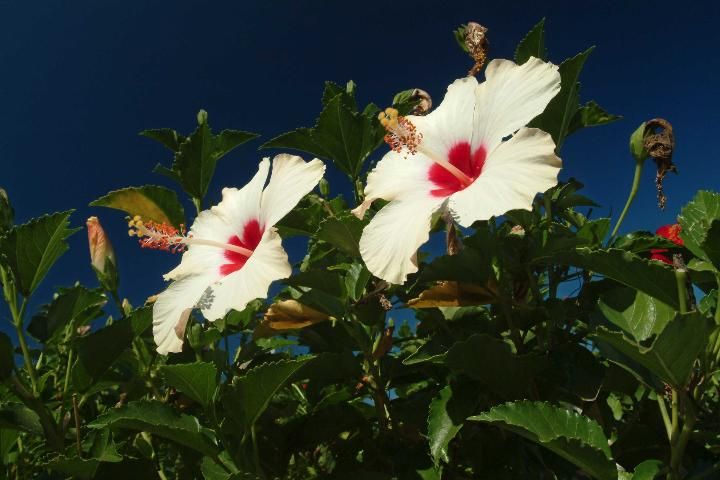
Credit: UF/IFAS Photo by Marisol Amador
Palms and cycads: Watch for nutrient deficiencies or other problems and use an appropriate treatment. Keep lawn fertilizers away from the root zone. See Palm Care: https://edis.ifas.ufl.edu/topic_palm_care
Pruning: Lightly prune summer-flowering shrubs, like hibiscus, oleander, and crapemyrtle, during the warmer months because they bloom on new growth. Azaleas can still be pruned until the middle of next month without harming next spring's buds. See Pruning Landscape Trees and Shrubs: https://edis.ifas.ufl.edu/topic_tree_pruning
Fertilizer Bans:Some municipalities in central Florida prohibit the application of fertilizer to lawns and/or landscape plants during the summer rainy season (June–September). See if such an ordinance exists in your area.
Soil solarization: Clean up your vegetable garden and solarize the soil to kill pests and disease. See Soil Solarization: https://edis.ifas.ufl.edu/topic_soil_solarization
July
What to Plant
Annuals/Bedding plants: Summer annuals to plant now include celosia, coleus, torenia, and ornamental pepper. See Annuals: https://edis.ifas.ufl.edu/topic_annual_landscape_plants
Bulbs: Butterfly lily and gladiolus can be planted during the middle of summer. See Bulbs for Florida: https://edis.ifas.ufl.edu/topic_bulbous_flowers
Herbs: While summer is too hot to start herbs from seeds, many do well if started from small plants. See Herbs: https://edis.ifas.ufl.edu/topic_herbs
Palms: Continue planting palms while the rainy season is in full swing. Support large palms with braces for 6–8 months after planting. Nails should not be driven directly into a palm trunk. See Palms: https://edis.ifas.ufl.edu/topic_palms
Vegetables: Start your Halloween pumpkins this month, but watch out for mildew diseases. Okra and Southern peas can also be planted. See Vegetable Gardening in Florida: https://edis.ifas.ufl.edu/topic_vegetable_gardening
What to Do
Trees: Prepare for hurricane season by checking trees for damaged or weak branches and pruning if needed. Hire an ISA-certified arborist. See International Society of Arboriculture: http://isa-arbor.com/ and Pruning Landscape Trees and Shrubs: https://edis.ifas.ufl.edu/topic_tree_pruning
Lawns: Determine the cause of any lawn problems before taking action. If an insect is the culprit, treat only the affected area. Rule out disease or sprinkler malfunction. See Garden Pest Insects: https://edis.ifas.ufl.edu/topic_garden_pest_insects
Fertilizer Bans:Some municipalities in central Florida prohibit the application of fertilizer to lawns and/or landscape plants during the summer rainy season (June–September). See if such an ordinance exists in your area.
Vegetable garden: Use summer heat to solarize the vegetable garden for fall planting. It takes 4–6 weeks to kill weeds, disease, and nematodes, so start now. See Soil Solarization: https://edis.ifas.ufl.edu/topic_soil_solarization
Azaleas: Prune no later than mid-July to protect developing buds for next spring's bloom. See Azalea: https://edis.ifas.ufl.edu/topic_azalea
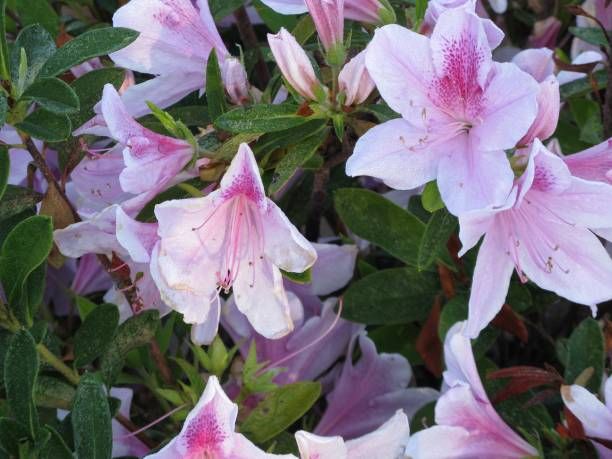
Credit: UF/IFAS
Irrigation: Install an inexpensive rain shutoff device to save money by overriding an irrigation system when it rains. If one is already installed, check that it is operating properly. See Landscape Irrigation: https://edis.ifas.ufl.edu/topic_landscape_irrigation
Pests on ornamental plants: Inspect the leaves of azaleas and ornamental plants for small white dots that may indicate lace bugs at work. Spray forcefully with water to help control this pest. See Landscape Pest Management: https://edis.ifas.ufl.edu/topic_landscape_pests and Landscape Lace Bug Pests: https://edis.ifas.ufl.edu/topic_landscape_lace_bug_pests
Citrus: Check citrus trees for damage to fruit or leaves and take action to minimize the effect of insects and/or disease on developing fruit and the overall health of the tree. See Home Citrus Culture: https://edis.ifas.ufl.edu/topic_citrus_home_citrus_culture
August
What to Plant
Annuals/Bedding plants: The hottest days of summer limit planting now to heat-tolerant annuals, such as coleus, kalanchoe, and vinca. See Annuals: https://edis.ifas.ufl.edu/topic_annual_landscape_plants
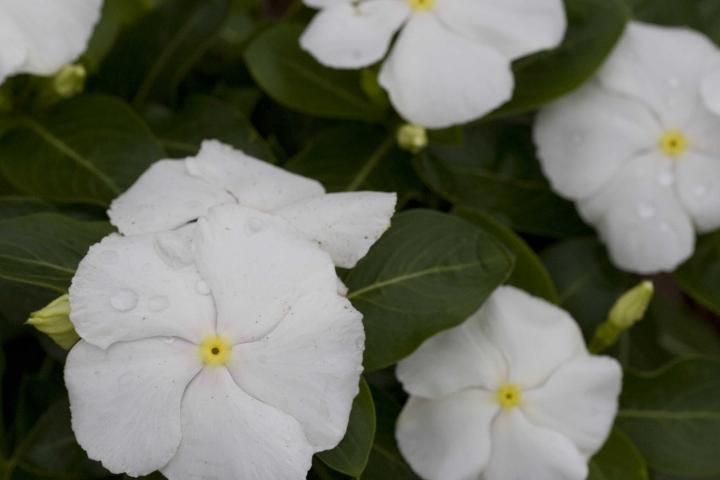
Credit: UF/IFAS Photo by Tyler Jones
Bulbs: Aztec lily, butterfly lily, walking iris, and spider lily can be planted any time of the year, even late summer. See Bulbs for Florida: https://edis.ifas.ufl.edu/topic_bulbous_flowers
Herbs: Herbs that can be planted from plants (not seeds) include bay laurel, ginger, Mexican tarragon, and rosemary. See Herbs: https://edis.ifas.ufl.edu/topic_herbs
Vegetables: Tomatoes, beans, carrots and others can be planted for the fall garden. See Vegetable Gardening in Florida: https://edis.ifas.ufl.edu/topic_vegetable_gardening
What to Do
Palms: Check older fronds for yellowing as it may indicate a magnesium or potassium deficiency. Apply an appropriate palm fertilizer. See Palm Nutrition and Fertilization: https://edis.ifas.ufl.edu/topic_palm_nutrition
Vegetables: Solarize the vegetable garden in preparation for fall planting if not done in July. See Soil Solarization: https://edis.ifas.ufl.edu/topic_soil_solarization
Poinsettias: Pinch back poinsettias and mums before the end of the month to allow time for buds to form for winter bloom. See Poinsettias: https://edis.ifas.ufl.edu/topic_poinsettia
Ornamental plants: Fertilize plants that show signs of deficiencies. Rapid growth and leaching rains may result in nutrient deficiencies in some plants. See Nutrient Deficiencies (Landscape Plants): https://edis.ifas.ufl.edu/topic_nutrient_deficiencies_landscape_plants
Fertilizer Bans:Some municipalities in central Florida prohibit the application of fertilizer to lawns and/or landscape plants during the summer rainy season (June–September). See if such an ordinance exists in your area.
Annuals/Bedding plants: Remove spent blooms, cut back, and fertilize flowering annuals and perennials to extend the bloom season into the fall months. See Annuals: https://edis.ifas.ufl.edu/topic_annual_landscape_plants and Perennial Landscape Plants: https://edis.ifas.ufl.edu/topic_perennials
September
What to Plant
Annuals/Bedding plants: If summer beds need refreshing, try ageratum, coleus, celosia, zinnia, and wax begonia for color into fall. See Annuals: https://edis.ifas.ufl.edu/topic_annual_landscape_plants
Bulbs: Add color, texture, and pattern to the garden with the many varieties of elephant's ear that are available. See Bulbs for Florida: https://edis.ifas.ufl.edu/topic_bulbous_flowers
Herbs: Plant herbs that tolerate the warm temperatures of early fall, such as Mexican tarragon, mint, rosemary, and basil. See Herbs: https://edis.ifas.ufl.edu/topic_herbs
Vegetables: It is hot, but numerous cool-season (as well as warm-season) crops can be planted. See Vegetable Gardening in Florida: https://edis.ifas.ufl.edu/topic_vegetable_gardening
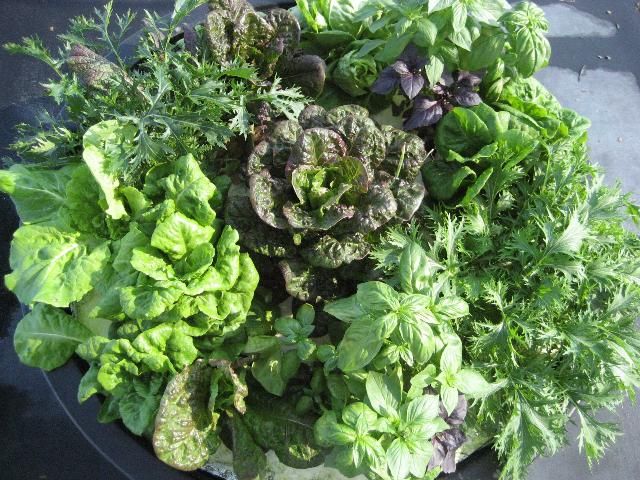
Credit: UF/IFAS
What to Do
Lawn problems: Continue to monitor the lawn for signs of insect damage. Fall armyworms, chinch bugs, mole crickets, and sod webworms are still active this month. See Turfgrass Pest Insects: https://edis.ifas.ufl.edu/topic_turf_pest_insects
Perennials and bulbs: Divide and replant perennials and bulbs that have grown too large or need rejuvenation. Add organic matter to new planting areas and monitor water needs during establishment. See Seeds and Propagation (Lawn and Garden): https://edis.ifas.ufl.edu/topic_garden_propagation
Irrigation: Check that irrigation systems are providing good coverage and operating properly before summer rains taper off. See Landscape Irrigation: https://edis.ifas.ufl.edu/topic_landscape_irrigation
Citrus: Fertilize citrus with a balanced fertilizer either this month or in October. If the weather has been rainy, do not use soluble nitrogen as rains will leach it from the soil too quickly. See Home Citrus Culture: https://edis.ifas.ufl.edu/topic_citrus_home_citrus_culture
Fertilizer Bans:Some municipalities in central Florida prohibit the application of fertilizer to lawns and/or landscape plants during the summer rainy season (June–September). See if such an ordinance exists in your area.
Vegetable gardens: Prepare the fall vegetable garden if not done in August. Using transplants from your local garden center will get the garden off to a fast start, but seeds provide a wider variety from which to choose. See Vegetable Gardening in Florida: https://edis.ifas.ufl.edu/topic_vegetable_gardening
October
What to Plant
Annuals/Bedding plants: Even though temperatures are still warm, begin planting for the cooler months ahead. Dianthus, petunia, and pansy are good annuals for the fall garden. See Annuals: https://edis.ifas.ufl.edu/topic_annual_landscape_plants
Bulbs: Plant agapanthus, rain lily, and many varieties of lilies now for blooms next spring or summer. Add organic matter to the planting bed for best results. See Bulbs for Florida: https://edis.ifas.ufl.edu/topic_bulbous_flowers
Herbs: A wide range of herbs can be planted from seeds or plants this month. Some examples include parsley, cilantro, chives, garlic, and sage. See Herbs: https://edis.ifas.ufl.edu/topic_herbs
Vegetables: Plant crops now that will grow and produce throughout the winter months. This includes broccoli, collards, kale, lettuce, and others. See Vegetable Gardening in Florida: https://edis.ifas.ufl.edu/topic_vegetable_gardening
What to Do
Lawn weeds: Control winter weeds in lawns before they appear. Preemergence herbicides must be applied at the right time to be effective. Apply when nighttime temperatures are 55°F–60°F for 4–5 days. Avoid "weed and feed" products. See Lawn Weeds: https://edis.ifas.ufl.edu/topic_lawn_weeds
Ornamental trees and shrubs: Fertilize plants that are not performing as desired. Controlled-release fertilizer provides nutrients over a longer period of time. See Nutrient Deficiencies (Landscape Plants): https://edis.ifas.ufl.edu/topic_nutrient_deficiencies_landscape_plants
Lawn fertilization: Early October is the last time to fertilize the lawn. Choose a fertilizer (not a "weed and feed") with little or no phosphorus unless a soil test indicates the need for it. A fertilizer with controlled-release nitrogen will give longer-lasting results. See Lawn Fertilizer: https://edis.ifas.ufl.edu/topic_lawn_fertilization
Strawberries: Prepare beds and set strawberry plants this month. Strawberries also make a colorful and tasty container planting. Either way, water daily until plants are established. See Strawberries: https://edis.ifas.ufl.edu/topic_strawberries
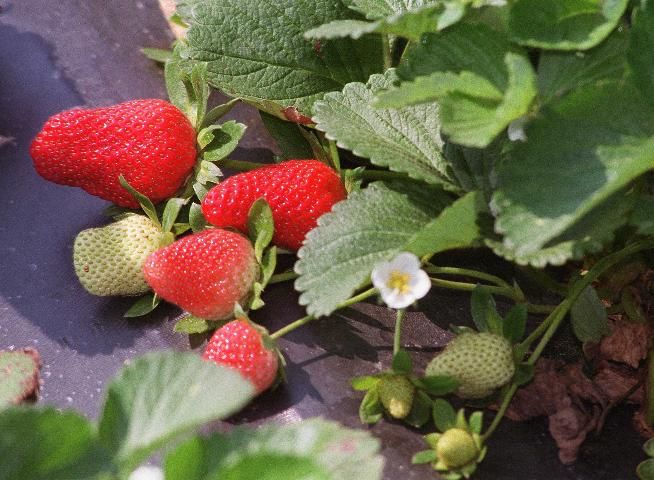
Credit: UF/IFAS
Winter landscapes: Plant evergreen hollies; their bright berries add color to the landscape when other plants have died back for the winter. Water well when planting and mulch to minimize weeds. See Holly: https://edis.ifas.ufl.edu/topic_holly
Twig girdlers: Control twig girdlers by cleaning up and destroying fallen branches that young twig girdlers can use for harborage. See Twig Girdlers: https://edis.ifas.ufl.edu/topic_twig_girdlers
November
What to Plant
Annuals/Bedding plants: Create a display of fall colors with cool-season plants. Some examples include pansy, viola, snapdragon, dianthus, cape daisy, and alyssum. See Annuals: https://edis.ifas.ufl.edu/topic_annual_landscape_plants
Bulbs: Many bulbs like to get their start in cool weather. Bulbs to plant this month include amaryllis, crinum, and daylily. See Bulbs for Florida: https://edis.ifas.ufl.edu/topic_bulbous_flowers
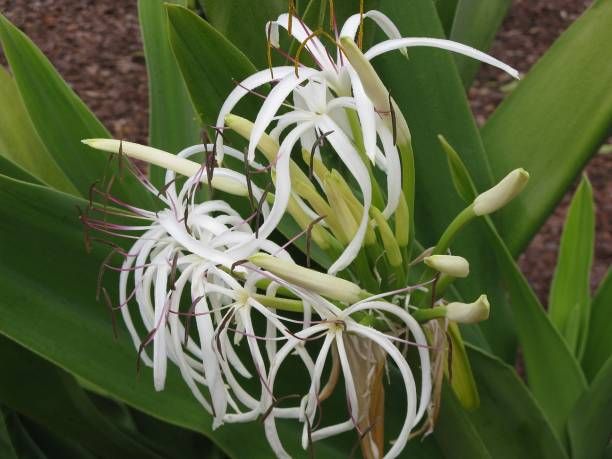
Credit: UF/IFAS
Herbs: Continue planting herbs from seeds or plants. A wide variety of herbs prefer cool, dry weather, including cilantro, parsley, sage, and thyme. See Herbs: https://edis.ifas.ufl.edu/topic_herbs
Vegetables: Continue planting cool-season crops, such as beets, broccoli, cabbage, carrot, kale, and lettuce. See Vegetable Gardening in Florida: https://edis.ifas.ufl.edu/topic_vegetable_gardening
What to Do
Perennials: Divide and replant overgrown perennials and bulbs now so that they establish before the cold weather arrives. See Seeds and Propagation (Lawn and Garden): https://edis.ifas.ufl.edu/topic_garden_propagation
Lawn disease: Watch for brown patch and large patch. These fungal diseases cause areas of grass to turn brown. Since treatment is difficult, prevention with proper cultural practices is key. These diseases become active when the soil temperature, measured 2–4 in. deep, is between 65°F and 75°F and go dormant when the weather warms in May. See Turf Diseases: https://edis.ifas.ufl.edu/topic_turf_diseases
Scale insects: Take advantage of lower temperatures to apply horticultural oil sprays to control scale insects. See Landscape Pest Management: https://edis.ifas.ufl.edu/topic_landscape_pests
Irrigation: Turn off systems and water only if needed. Plants need less supplemental watering in cooler weather. See Landscape Irrigation: https://edis.ifas.ufl.edu/topic_landscape_irrigation
Poinsettias: Watch for hornworms on poinsettias planted in the landscape. This pest can quickly defoliate the plant; handpick or treat only the infested area. See Poinsettias: https://edis.ifas.ufl.edu/topic_poinsettia
December
What to Plant
Annuals/Bedding plants: To add color to the winter garden, plant masses of petunia, pansy, and snapdragon. See Annuals: https://edis.ifas.ufl.edu/topic_annual_landscape_plants
Bulbs: Amaryllis is a popular plant for the holiday season. It can be forced to bloom now or planted outdoors for spring blooms. See Bulbs for Florida: https://edis.ifas.ufl.edu/topic_bulbous_flowers
Herbs: Plant herbs that thrive in cool weather. Some examples include parsley, thyme, sage, dill, fennel, and cilantro. See Herbs: https://edis.ifas.ufl.edu/topic_herbs
Vegetables: Reliable cool-season vegetables to plant this month include celery, cauliflower, lettuce, cabbage, and carrot. See Vegetable Gardening in Florida: https://edis.ifas.ufl.edu/topic_vegetable_gardening
What to Do
Poinsettias: Enjoy one of the most popular indoor holiday plants. Protect it from cold until spring, and then plant it in the garden for next year. See Poinsettias: https://edis.ifas.ufl.edu/topic_poinsettia

Credit: UF/IFAS Photo by Tyler Jones
Cold protection: Prepare now to protect tender plants should cold weather threaten. See Cold Protection and Chilling Damage of Landscape Plants: https://edis.ifas.ufl.edu/topic_landscapes_and_cold
Lawn disease: Continue to watch for brown patch and large patch, fungal diseases that cause areas of grass to turn brown. Since treatment is difficult, prevention with proper cultural practices is key. These diseases become active when the soil temperature, measured 2–4 in. deep, is between 65°F and 75°F and go dormant when the weather warms in May. See Turf Diseases: https://edis.ifas.ufl.edu/topic_turf_diseases
Houseplants: Inspect regularly for pests on indoor plants. Keep in mind that plant-specific temperature, light, and humidity are key to ensuring that indoor plants thrive. See Houseplants: https://edis.ifas.ufl.edu/topic_house_plants
Soil test: Consider performing a soil test if plants do not perform as desired or if new plantings are planned. See Soil Testing: http://solutionsforyourlife.ufl.edu/hot_topics/agriculture/soil_testing.html and Soil Testing (Home Lawn and Garden): https://edis.ifas.ufl.edu/topic_home_soil_testing
Compost/mulch: Use fallen leaves to provide the carbon ingredient needed for successful composting and also to make a good mulch. See Backyard Composting: https://edis.ifas.ufl.edu/topic_home_composting and Landscape Mulches: https://edis.ifas.ufl.edu/topic_mulch
Landscape and garden pests: Continue monitoring and treat as needed. While cooler weather generally means fewer pests, some populations actually increase at this time of year. See Garden Pest Insects: https://edis.ifas.ufl.edu/topic_garden_pest_insects and Landscape Pest Management: https://edis.ifas.ufl.edu/topic_landscape_pests
What to Do Every Month
Adjust irrigation based on rainfall. See Landscape Irrigation: https://edis.ifas.ufl.edu/topic_landscape_irrigation
Prune off dead blooms and seeds to encourage new flowers.
Monitor for insects and disease.
Plant trees, shrubs, and flowering annuals/perennials and water until established.
See The Florida-Friendly Landscaping™ Guide to Plant Selection and Landscape Design at https://ffl.ifas.ufl.edu/homeowners/publications.htm
Warm Months—Mow lawns at recommended heights: https://edis.ifas.ufl.edu/lh028
UF Resources for Gardeners
UF/IFAS Publications (EDIS): https://edis.ifas.ufl.edu/
Florida-Friendly Landscaping™: http://fyn.ifas.ufl.edu/
Gardening Solutions: http://gardeningsolutions.ifas.ufl.edu/
Florida Master Gardener Program: http://gardeningsolutions.ifas.ufl.edu/mastergardener/
Living Green: http://livinggreen.ifas.ufl.edu/
UF Books, Flash Cards, Apps and other gardening resources: http://ifasbooks.ifas.ufl.edu/
Planting dates and other vegetable gardening information are also available as a free mobile app called 'Florida Fresh.' Access an app provider for your mobile phone or download it from http://m.ifas.ufl.edu.
Acknowledgements
The author wishes to thank Carolyn Wildes and Mary Derrick for their time and dedication to the Florida Gardening Calendar project.


